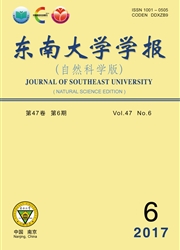

 中文摘要:
中文摘要:
采用原位聚合法制备了以三聚氰胺改性脲醛树脂为壁材,聚甲基丙烯酸甲酯(PMMA)修饰二氧化钛为显示颗粒,四氯乙烯为分散介质的电子墨水微胶囊,并对制备工艺进行优化.采用光学显微镜和扫描电子显微镜研究了反应体系pH值、不同表面活性剂和固化剂等对微胶囊的成囊效果、表面形貌及壁材强度的影响.结果表明:采用质量分数为1%甘油做表面活性剂,可适当调节油/水界面张力,抑制微胶囊化过程中的黏结团聚;通过调节体系pH值,控制缩聚反应速率,可有效抑制水相中絮状树脂的产生,得到表面光滑的微胶囊;采用氯化铵作固化剂对微胶囊进行固化,可有效提高微胶囊的机械强度,得到在自然干燥后不破裂的微胶囊.
 英文摘要:
英文摘要:
Microcapsules of E-ink was prepared through in situ polymerization, in which titanium dioxide modified by PMMA (polycmethye methacry late) was introduced as displaying particles dispersed in carbon dichloride, and urea-formaldehyde resin modified with melamine as wall material. Also, the polymerization process was studied to optimize the reaction conditions. Optical microscope and electronic microscope were used to observe the effects of various process conditions, including the variety of system pH, surfactant and curing agents, on the encapsulation performance, microcapsule surface and wall strength. The results show that glycerol, as surfactant, with a concentration of 1% can alternate the interfacial tension between water and oil to some extent; thusly, the conglomeration problem can be inhibited during the microencapsulation process. Meanwhile, by controlling the reaction rate of condensation polymerization and adjusting the pH of the system, the floccules can be restrained effectively, and microcapsules with smooth surfaces are obtained. Finally, the addition of NH4CI may result in properly strengthened microcapsules to resist the collapse during nature drying.
 同期刊论文项目
同期刊论文项目
 同项目期刊论文
同项目期刊论文
 期刊信息
期刊信息
